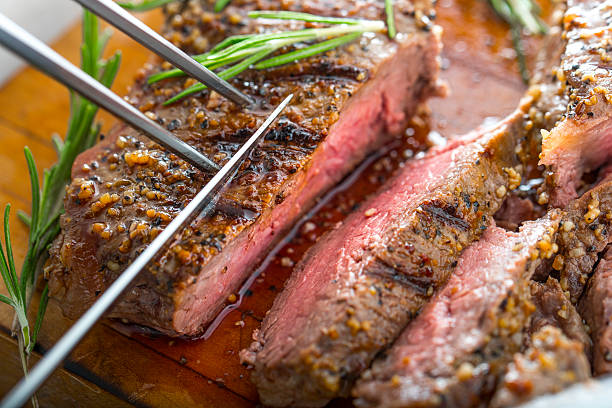A well-cooked steak deserves the right tool for the job—a quality steak knife that can effortlessly slice through the meat without tearing it apart. While the steak itself plays a significant role in the culinary experience, the steak knife completes the journey to a perfect bite.
The History of Steak Knives
The history of steak knives is a fascinating journey that mirrors the evolution of dining and culinary tools. The concept of using a dedicated knife for steak dates back centuries when meat was a precious commodity, and a well-made knife was a sign of luxury. Over time, steak knives have evolved from being primarily utilitarian to becoming a symbol of craftsmanship and fine dining.
The steak knife as we know it today gained popularity in the United States during the 19th century. As the culture of grilling and steak consumption flourished, so did the demand for specialized knives designed to handle these hearty cuts of meat. Modern steak knives are a testament to both form and function, designed not only to cut steak effortlessly but also to enhance the dining experience.
Types of Steak Knives
Steak knives come in various types and styles, each with its own unique characteristics and advantages. Let’s explore the most common types:
1. Straight-Edged Steak Knives
Straight-edged steak knives are the classic choice. They feature a sharp, straight blade that’s easy to sharpen and maintain. These knives are ideal for precision cutting and offer a clean, smooth slice through the steak.
2. Serrated Steak Knives
Serrated steak knives have a toothed or scalloped edge that can grip the meat’s surface, making it easier to cut through without tearing. They are excellent for tougher cuts of meat and bread but may require more maintenance to keep the serrations sharp.
3. Hollow-Edge Steak Knives
Hollow-edge steak knives, also known as granton-edge knives, have small divots or hollows along the blade. These divots reduce friction, allowing for smoother and more precise slicing. They are great for delicate cuts of meat and have an elegant appearance.
4. Ceramic Steak Knives
Ceramic steak knives are lightweight, razor-sharp, and resistant to staining. They are an excellent choice for those who want a knife that stays sharp for a long time. However, they can be more brittle than their metal counterparts.
5. Steak Knife Sets
Steak knife sets typically include multiple knives in a matching style. These sets can be a stylish addition to your tableware, and they ensure consistency in your dining experience. Sets are available in various types, from straight-edged to serrated knives.
Factors to Consider When Choosing a Steak Knife
Selecting the perfect steak knife requires careful consideration of several factors:
1. Blade Material
The type of steel used in the blade greatly influences its sharpness and durability. High-carbon stainless steel is a popular choice for its balance of sharpness and corrosion resistance.
2. Blade Length
Steak knives typically have blades ranging from 4 to 5 inches. Choose a length that complements your steak-eating habits, as longer blades provide more slicing power.
3. Handle Material
The handle material affects the knife’s grip and comfort during use. Common options include wood, plastic, metal, and synthetic materials. Choose a handle that feels comfortable in your hand and complements your table setting.
4. Full Tang vs. Partial Tang
A full tang knife has the blade extending through the handle, providing stability and balance. Partial tang knives have the blade attached to a portion of the handle. Full tang knives are often more durable.
5. Sharpness and Maintenance
Consider the knife’s initial sharpness and how easy it is to maintain. High-quality knives should be easy to sharpen and hone when needed.
6. Design and Style
Steak knives come in a variety of designs, from classic to contemporary. Choose a style that matches your personal preferences and complements your tableware.
7. Presentation and Storage
Think about how you’ll present and store your steak knives. A wooden block or magnetic strip can keep your knives organized and easily accessible.
The Culinary Experience
Using the right steak knife enhances the culinary experience. It ensures that each bite of steak is a pleasure to savor, free from any unpleasant tearing or struggle. A quality steak knife should glide through the meat effortlessly, allowing you to enjoy the flavors and textures of the steak without disruption.
Caring for Your Steak Knives
Proper care ensures that your steak knives maintain their sharpness and longevity. Here are some essential tips:
1. Handwashing
Always handwash your steak knives with mild soap and warm water. Avoid aggressive scrubbing or abrasive materials that could damage the blade.
2. Drying and Storage
Thoroughly dry your steak knives after washing to prevent corrosion. Store them in a knife block, on a magnetic strip, or in a knife drawer organizer to keep them safe and accessible.
3. Sharpening
Regularly sharpen your steak knives using a honing rod or a sharpening stone. Properly maintained blades ensure smooth slicing.
4. Honing
Use a honing rod to realign the blade’s edge between sharpening sessions. This helps maintain the knife’s cutting performance.
A perfect steak is a work of culinary art, and the right steak knife is the brush that allows you to fully appreciate it. The ideal steak knife should match your dining preferences and enhance your overall eating experience.
